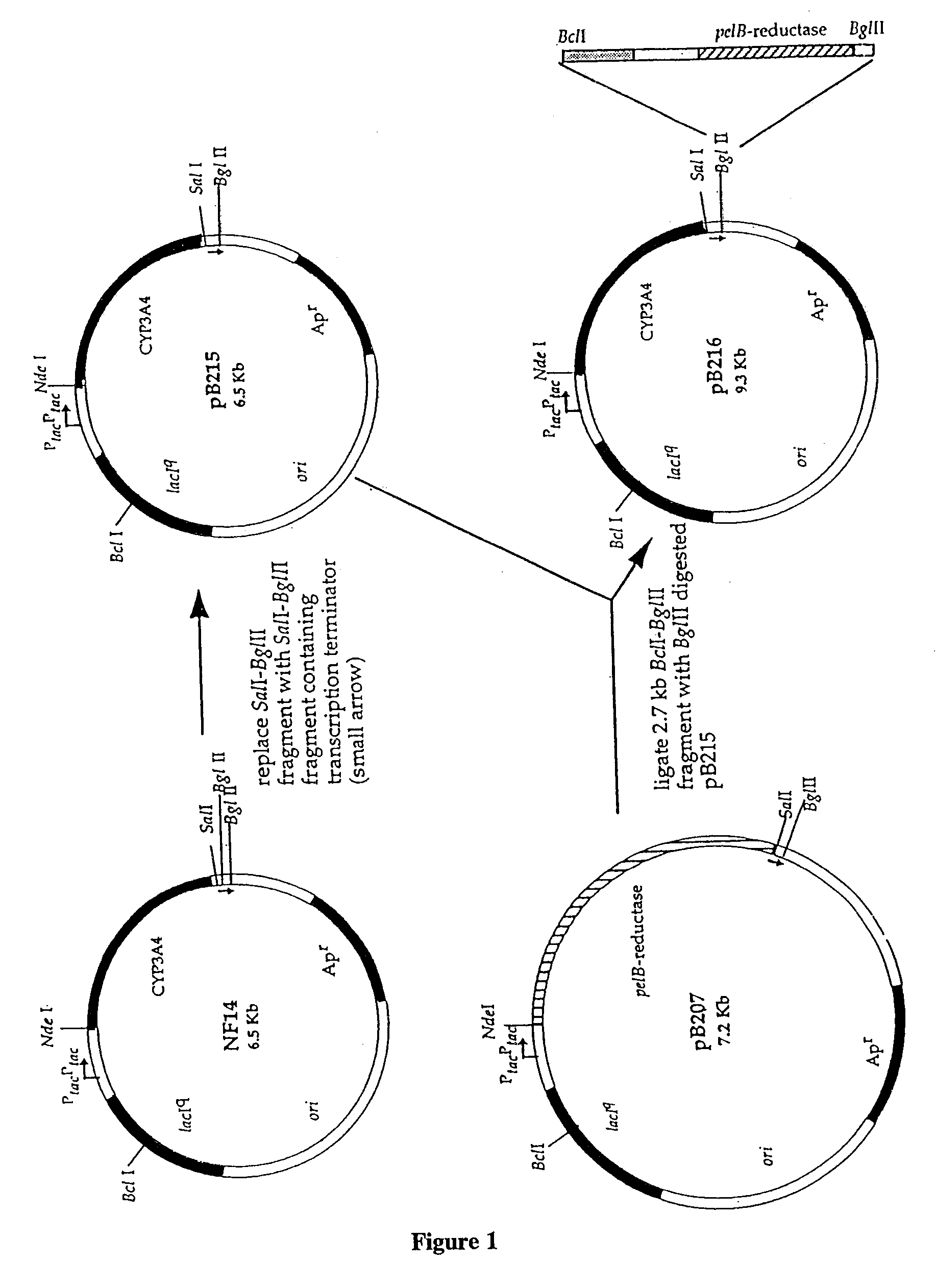Expression of functional cytochrome P450 monooxygenase system in enterobacteria
a cytochrome p450 monooxygenase and functional technology, applied in the field of cytochrome p450 monooxygenase, can solve the problems of no bacterial cell system previously devised, no system capable of metabolising compounds in whole cells, no satisfactory system has so far been devised, etc., to minimise the potential for mrna secondary structure, improve translatability, and large effect on tr
- Summary
- Abstract
- Description
- Claims
- Application Information
AI Technical Summary
Benefits of technology
Problems solved by technology
Method used
Image
Examples
example 2
Materials and Methods
Bacterial Strains and Plasmids
The E. coli K-12 strain JM109 (Yanisch et al (1985) Gene 33, 103-19) was used throughout. Cytochrome P450 cDNAs were expressed from the plasmid pCW. This plasmid includes a .beta.-lactamase gene, and can therefore be stably maintained in bacterial cells grown in the presence of an agent such as ampicillin or carbenicillin. The human P450 reductase cDNA was expressed from the plasmid pACYC184, which can be stably maintained in bacterial cells in the presence of chloramphenicol.
Isolation of Bacterial Signal Peptide Coding Sequences and Generation of Expression Constructs
The source of the coding sequence for the bacterial pelB signal peptide was the commercial vector pET-20b (Novagen). Chromosomal DNA was extracted from E. coli strain JM109 and used as the template for the isolation of the ompA leader sequence by PCR, using specific oligonucleotide primers. This PCR product was sub-cloned and subjected to dideoxy sequencing, and was fo...
example 3
Expression in Salmonella typhimurium
Coexpression of P450 and P450s in certain S. typhimurium strains such as TA1538 and TA1535 is readily adapted from the E. coli system described above. The same vector system can be employed in both species. The vector is first passaged from the E. coli strains which are used for P450 expression (eg. JM109 or DH5.alpha.) through the E. coli strain LA5000 and from there to the S. typhimurium strains. However for the expression of P450s in the S. typhimurium strains TA98 and TA100, which are frequently used in mutagenicity testing, the strategy may have to be slightly modified. TA98 and TA100 carry the plasmid pKM101 which increases the SOS repair in these strains and concomitantly their sensitivity to mutagens. However this plasmid codes also for the ampicillinase. For the expression of P450s from the expression plasmid pCW in these strains, the ampicillinase marker on pCW has to be replaced by a tetracycline resistance marker. Otherwise growth cond...
example 4
Expression of CYP3A4 and P450 Reductase in Escherichia coli and Salmonella typhimurium Strains with Altered Outer Membrane Permeability
Materials and Methods
Bacterial Strains and Plasmids
The E. coli K12 strains used were JM109 (Yanisch et al (1985) Gene 33, 103-19), AB1157 (Howard-Flanders et al (1964) Genetics 49, 237-246) and NS3878 (Chaterjee and Sternberg (1995) Proc. Natl. Acad. Sci. 92, 8950-8954). The S. typhimurium strain was TA1535 (Ames et al (1975) Mutat. Res. 31, 347-352)). NS3678 is strain AB1157 tolC (.lambda.LP1) and the tolC mutation is due to a Tn10tet.sup.r insertion. TolC.sup.- mutants are extremely sensitive to hydrophobic agents (Whitney (1970) Genetics 30, 39-59) and this protein is proposed to play a role in assembly of lipopolysaccharide (LPS) in the outer membrane (Schnaitmann and Klena (1993) Microbiol. Rev 57, 655,682). S. typhimurium strain TA1535 carries an rfa mutation and has a defective outer membrane. Co-expression of CYP3A4 and P450 reductase was ach...
PUM
| Property | Measurement | Unit |
|---|---|---|
| pH | aaaaa | aaaaa |
| pH | aaaaa | aaaaa |
| volume | aaaaa | aaaaa |
Abstract
Description
Claims
Application Information
 Login to View More
Login to View More - R&D
- Intellectual Property
- Life Sciences
- Materials
- Tech Scout
- Unparalleled Data Quality
- Higher Quality Content
- 60% Fewer Hallucinations
Browse by: Latest US Patents, China's latest patents, Technical Efficacy Thesaurus, Application Domain, Technology Topic, Popular Technical Reports.
© 2025 PatSnap. All rights reserved.Legal|Privacy policy|Modern Slavery Act Transparency Statement|Sitemap|About US| Contact US: help@patsnap.com



